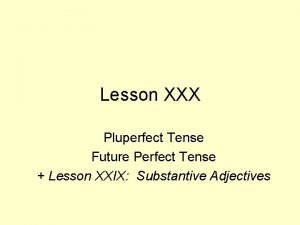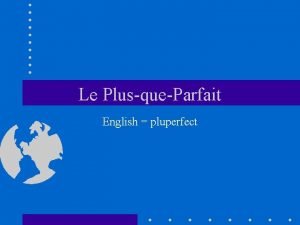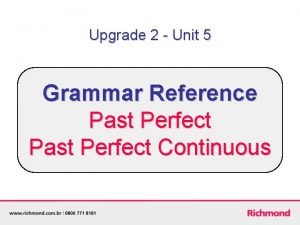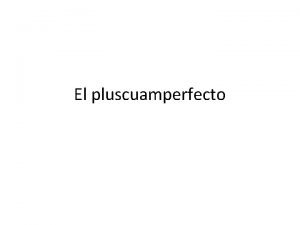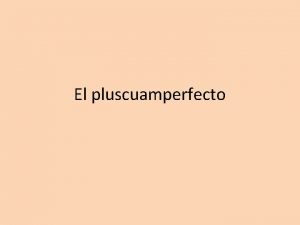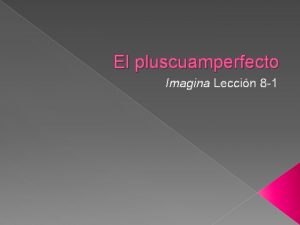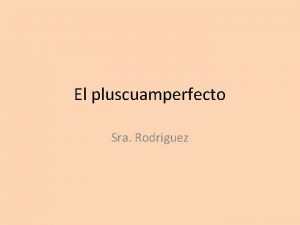Past Perfect Pluperfect Pluperfect Past Perfect Pluscuamperfecto The











- Slides: 11

Past Perfect (Pluperfect)

Pluperfect (Past Perfect) (Pluscuamperfecto) The past perfect (also called the pluperfect and, in Spanish, the pluscuamperfecto) is the past of the past and translates with “had” in English. ALL perfect tenses get a helping verb and a past participle: present perfect past perfect future perfect conditional perfect he has eaten he had eaten he will have eaten he would have eaten

The past perfect isn’t hard to explain, but we don’t always use it when we should. The past perfect (also called “pluperfect”) is, as was mentioned in the previous slide, the past of the past. Juan had already eaten when we arrived. Both actions (“eaten” and “arrived”) are in the past. But the eating happened before the arriving. So “arrived” is past, and “had eaten” is the past of that—the past of the past.

Past Participle All perfect tenses are made up of two parts: the helping verb and the past participle of the main verb: helping verb past participle He had eaten. They had left. I had studied. helping verb past participle We had seen. You had finished. She had fallen.

This is how you form the past participle in Spanish: Drop the –ar and add –ado: hablar pensar llegar hablado pensado llegado nadar almorzar estar nadado almorzado estado Drop the –er or –ir and add –ido: comer leer asistir comido leído asistido poder querer venir podido querido venido

Click here to go to a brief practice exercise.

There are, of course, irregular past participles in Spanish as there are in English. call jump look eat bring had called had jumped had looked had eated? ? had bringed? ? had eaten had brought

You have to memorize the irregular past participles in Spanish just as you do in English. volver poner abrir cubrir escribir ver morir decir hacer romper vuelto (NOT volvido) puesto (NOT ponido) abierto etc. cubierto escrito visto muerto dicho hecho roto

The helping verb is the imperfect of “haber”: había hablado habías hablado habíamos hablado habíais hablado habían hablado “Había” is “I had”; “hablado” is “spoken. ” So “había hablado” is “I had spoken. ” Había comprado – I had bought habíamos visto – we had seen Habías vivido – you had lived habíais creido – y’all had believed Había dicho – he had said habían escrito – they had written

Don’t forget how to form the past participle: Drop the –ar and add –ado: hablar hablado pensar pensado llegar llegado nadar almorzar estar nadado almorzado estado Drop the –er or –ir and add –ido: comer leer asistir comido leído asistido poder querer venir podido querido venido And don’t forget the irregular ones: volver abrir escribir morir hacer vuelto abierto escrito muerto hecho poner cubrir ver decir romper puesto cubierto visto dicho roto

Click here to go to a brief practice exercise. Click here to go to your homework.








